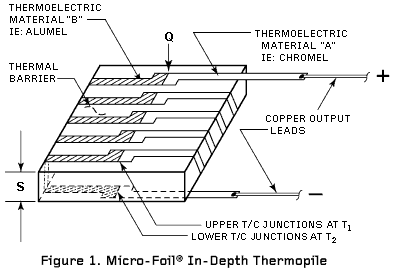|
The Micro-Foil® heat flow sensor is a differential thermocouple type sensor which utilizes a thin foil type thermopile bonded to both sides of a known thermal barrier as shown in Figure 1.
The difference in temperature (DT) across the thermal barrier is proportional to heat flow through the sensor. Thermoelectric junctions are formed from materials “A” and “B” on the upper surface of the barrier. In series with these are corresponding junctions mirror imaged on the lower surface. This construction results in an equal number of junctions on the upper and lower surfaces. The two output leads are of the same material, with one coming from the first junction on the upper surface and the other from the last junction on the lower surface.
 |
In actuality, only one pair of junctions is required for a completed sensor; however the output signal and sensitivity are directly proportional to the number of paired junctions. Each pair of upper and lower junctions forms a differential thermocouple with voltage output proportional to a small DT. Multiple pairs of junctions in series are used to increase signal and resolution. This assembly is called an in-depth thermopile because heat flows in series through a barrier from hot to cold junctions.
The output signal represents local heat transfer where the sensor is mounted. The sensor is placed in intimate contact with the surface or body for which heat transfer rates are desired. The same energy must pass through the sensor as is associated with the surface to which it is
attached. Any time thermal energy passes through a material — in this case the thermal barrier — a temperature gradient DT is generated. This gradient is directly proportional to the magnitude of the thermal energy flowing through the barrier—the heat transfer rate.
The factors that effect the magnitude DT are the heat transfer rate (Q), thickness of the barrier (S), and the thermal conductivity (K) of the barrier material. The following simplified expression is given showing the relationship between these factors:
 |
(1) |
|
The characteristic 63% response time for a Micro-Foil® sensor is approximated by:
 |
(2) |
t = response time
r = density
Cp = specific heat
K = thermal conductivity
X = cover layer factor
A1.2 (thick S) to 2 (thin S) |
Thin sensors provide both fast response and straight-thru heat flow.
|




